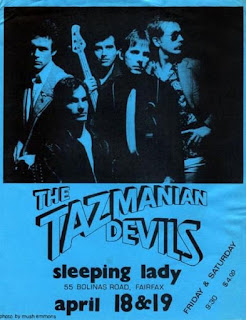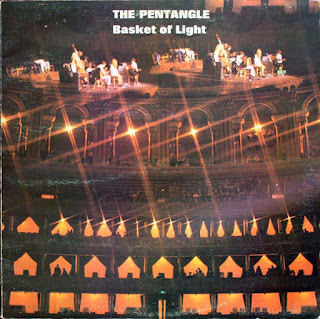 |
| The Tuesday February 25, 1975 San Francisco Examiner entertainment listings include "Country Rock Dance--The Good Old Boys and Soundhole, at Keystone Berkeley, 2119 University Ave 9pm" |
Garcia scholars now know that Jerry, Frank Wakefield and David Nelson played two shows at a club called Margarita's in Santa Cruz, on the weekend of February 20 and 21, 1975. We know this not only because a fellow blogger was an eyewitness who recalled the events clearly, but because a fine double-cd was released of the performances in 2019. At the end of January 1975, Garcia and Nelson had recorded the All-Star bluegrass album with Wakefield, fiddler Chubby Wise and banjo player Don Reno. The album Pistol Packin' Mama was not released until January 1976, and the band was called The Good Old Boys. Yet The Good Old Boys had played Margarita's in February of 1975, with Garcia playing banjo in place of Don Reno. Reno and Chubby Wise had left town, so Garcia had surely practiced his banjo to get ready to stand in.
Guess what? Three days later, on Tuesday, February 25, the listing in the day's San Francisco Examiner noted "Country Rock Dance: The Good Old Boys and Soundhole at Keystone Berkeley, 2119 University Avenue, 9pm." Garcia, per the golden source of Jerrybase, was known to have played Keystone Berkeley 242 times. I'm going to argue that Garcia didn't work up his banjo chops just for a weekend in Santa Cruz, and make the case for 243.
 |
| From the Feb 21-28 Berkeley Barb Scenedrome entertainment listings. For Tuesday, February 25, the Good Ol' Boys are listed at the Sleeping Lady Cafe |
Let's review.
 |
| Drink Up And Go Home, an archival double cd on RockBeat Records, released in 2019. Featuring Jerry Garcia, Frank Wakefield and David Nelson, recorded in Santa Cruz, CA on February 20& 21, 1975 |
February 25, 1975 Keystone Berkeley, Berkeley, CA: Good Old Boys/Soundhole "Country Rock Dance" (Tuesday)
While the Keystone Berkeley was generally a thriving nightclub throughout the 1970s, as far as I can tell, it wasn't flying as high in 1975 as it had a few years earlier. The Keystone had a Fillmore West feel to it, a lot of people on their feet, a lot of blues, a lot of guitar solos. In retrospect, we look back and see Jerry Garcia, Elvin Bishop and John Lee Hooker, and it sounds pretty cool. And it surely was. But in 1975, it wasn't forward looking. Hippies weren't unhip yet, as that would happen when punk and New Wave arrived in Berkeley two years later, but they were a bit passe. Very few touring acts played Keystone Berkeley at this time, save for blues acts who had fewer venues than ever. The bands were mostly local, even though some of them (like Garcia or Bishop) were substantial locals with albums.
Still, Keystone Berkeley sold beer, lots and lots of beer, so it was a hangout as well as a destination. Keystone Berkeley was at Shattuck and University, right below the UC Berkeley Campus and right downtown. Plenty of students and former students lived within walking distance of Keystone, and enough of them would have been over 21. There were almost no music bars on Shattuck Avenue at the time, and frankly almost no bars either. So if you liked to spend a weeknight with a cold one and some loud guitar, Keystone Berkeley was about your only choice near campus. Most nights of the week save Tuesday, Keystone Berkeley was open, and mostly for $1.00 or no cover at all, with a local band playing. It was the Bay Area--often the local bands were pretty good. Sunday and Monday were for local bands for a $1.00, and Tuesdays and sometimes Wednesdays were dark unless there was something unique to book.
On Monday, February 24, Keystone Berkeley had booked Soundhole. Soundhole was Marin County band that had formed around 1973. In 1974, Soundhole had hired on as Van Morrison's backing band, so they had a certain status around the Bay Area, even if they had never made an album. Soundhole played rock with some jazz and soul edges, appropriately enough in the style of mid-70s Van Morrison. Soundhole never did make an album (you can find a Nov 26 '74 Winterland tape if you poke around Wolfgang's Vault), but most of the band members went on to bigger things. Guitarist Brian Marnell was in SVT, with Jack Casady, organist John Farey was in Zero, and saxophonist Johnny Colla, bassist Mario Cipollina and drummer Bill Gibson would go on to Huey Lewis and The News (tenor saxophonist Brian Hogan was the other member). Soundhole were good, the type of band who would be booked for $1.00 on a Monday night at Keystone Berkeley. University and Shattuck was just an hour from San Rafael, and what else would Soundhole have been doing? Have a little fun, maybe make some coin.
But here's what--Soundhole were Marin funky, like the Sons Of Champlin. They don't play country rock. So why does the Examiner listing say "Country Rock Dance?" Keep in mind, the Examiner was San Francisco's afternoon paper (the larger Chronicle was the morning paper). A club could get a listing added to the paper the day before, and possibly that same day if they called at the beginning of the day. Here's what I think--the Good Old Boys enjoyed their weekend gig in Santa Cruz. I think they decided to keep playing, so someone in the Dead office made some calls.
Soundhole was booked for Monday, February 24. On Wednesday, Keystone had a relatively big show with a touring band--the great Welsh band Man, with Deke Leonard--so that left Tuesday, usually a dark night. I think Freddie Herrera told Soundhole they should stick around, and booked Garcia and the Good Old Boys on the fly. Keystone staff would have called the Examiner on Monday afternoon or Tuesday morning, which was too late for the Tuesday Chronicle deadline.
We know that Garcia would have been sensitive to being advertised at a place like Keystone when he wasn't going to be playing electric guitar and covering Motown and Dylan songs, so I think he didn't want his name on the booking. But Keystone saying "country rock dance" even when the band was the funky Soundhole was code for Herrera letting people who had heard a rumor about Garcia think "this might be him..." I think they played. My guess is Good Old Boys played a set or two of bluegrass, and Soundhole plugged in and funked out until well after midnight.
The Good Old Boys at The Sleeping Lady Cafe, Fairfax, CA
The Berkeley Barb for the week of February 21-28, 1975 has a listing for the Good Old Boys at the Sleeping Lady Cafe in Fairfax for Tuesday, February 25. This conflicts with the Keystone date. The deadline for the Barb would have been the week before (probably Tuesday February 18), so I'm confident that the Tuesday Examiner listing at the Keystone supersedes the Sleeping Lady. Still, I think the band played there, probably on Monday or Wednesday.
The Sleeping Lady Cafe was at 58 Bolinas Avenue in Fairfax, in Marin County. Fairfax is a tiny town, just 2.2 square miles, incorporated in 1931. It is 3 miles Northwest of San Rafael, and at the time had a population of about 7,500 (as it does now). As for the Sleeping Lady itself, it was the first vegetarian restaurant in Marin County, and the first restaurant in Marin to ban smoking indoors. So that made it a hippie hangout from its inception. It had singers and bands from the beginning, and the performers were local, as in "lived down the street" local. For a long time in the mid-70s, the Sleeping Lady hosted a band called the Fairfax Street Choir, a full rock band with a dozen singers. This quixotic enterprise had numerous Marin connections (e.g. Donna Jean Godchaux's future husband was the bass player, and so on), but was financially impossible. The Sleeping Lady was just a hangout for hippies who liked music.
It sounds to me like The Good Old Boys booked a gig there, and when Keystone Berkeley called, they bumped it. Makes sense. There is one extremely intriguing piece of evidence, however, that makes me think the Good Old Boys actually played the Sleeping Lady. Garcia scholars may know of Michelle McFee, a wonderful person with whom I have not been in touch with in a while (wherever you are, Michelle, I hope you are well). Michelle McFee, who lived in Kentfield, was among many other things the Office Manager for the New Riders of The Purple Sage, and as connected as one could be to the Marin County music scene. For many years, her on-line handle was "Pistol Packin' Mama" (and in other contexts, "MizShely"). So she identified with the Good Old Boys (and remember, she knew them all).
A google search of The Sleeping Lady and the Good Old Boys, rather surprisingly, turns up a stale website called Marin Nostalgia. Under the header, "Memories of The Sleeping Lady" what do we find? Well, well, Michelle---
Was a hideous ugly place in the 70s…small and somewhat scary, my fondest memory of the place was one night The Good Old Boys were playing and Peter Sheridan went to sitting in a chair and sat right on through it, thuddng on to the floor. In the immortal words of one of Bette Davis’ characters, “WHAT a dump…” — Michelle McFee
Yes, it's possible that Michelle McFee was referring to seeing later versions of The Good Old Boys, without Garcia (most Wakefield ensembles since have been called "The Good Old Boys"). But since Michelle thought it was a scary dump, why would she go? The answer, to me, was that Garcia was playing. Remember, she worked for and with David Nelson at the time, so she would have known.
So I think the Good Old Boys weekend in Santa Cruz went well, and they called Freddie Herrera, who offered them Tuesday. The boys told the Sleeping Lady that they would play a different day, probably Monday February 24, and they did. A few friends of the band, like Michelle McFee, dropped by, and some Bolinas locals dropped in.
Comments, Wayback Machine searches, and any rank speculation widely encouraged. For now, I'm going with this:February 25, 1975 Keystone Berkeley, Berkeley, CA: Good Old Boys/Soundhole "Country Rock Dance" (Tuesday)
February 24 or 26, 1975 Sleeping Lady Cafe, Bolinas, CA: Good Old Boys (Monday or Wednesday)








